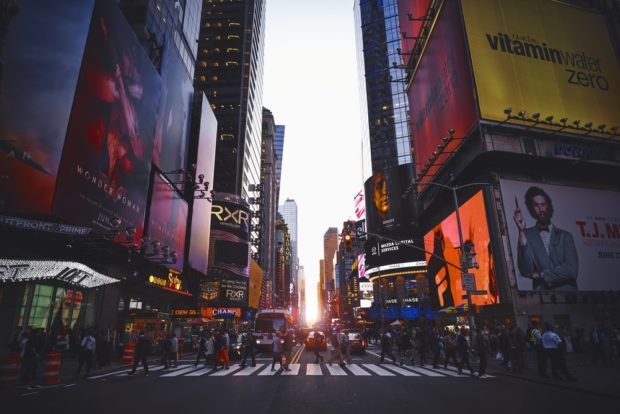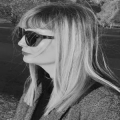You have no items in your cart. Want to get some nice things?
Go shopping
In 2016, I finally made it to New York. I had only ten days there; and I ran around that city like I only had ten days left to live. I had managed to wangle a stay for my partner and I in a dingy, tiny, fifth-floor apartment with no lift – but it was on the Upper East Side, and I never felt more glamorous. We saw the view from the Rockefeller, read the poem on Liberty Island, and drank Bellinis at Grand Central Station. We went up the Empire State Building at midnight to be awed by the lights, the murmur of the traffic below, the romance. I didn’t care about the rats, the heaps of rubbish on the streets, the income inequality – all that was just like home, after all. I did not want to see Ground Zero.
To me, there are two seasons in this city. The first is Christmastime, with outdoor ice-skating and shopping in Bloomingdales, and scenes from Donna Tartt novels. The second is high summer, which means athleisure, gold hooped earrings, and beatbox stereos. We were there for neither, and needless to say, neither really exists. We were there in spring. We were there for the first Monday in May, and saw the red carpet rolled out for the Met Gala.
We ate bagels for breakfast and bought black-and-white cookies to take home each night – which we could not locate back in London for love nor money. (Not even Hummingbird Bakery does them in the UK.) We ate out every night, but we most loved the diners – something we do not quite have an equivalent for back home.
Conceding a temporary pause, we watched the first episode of Friends, a random episode of Seinfield, and an American news programme. There was a commentator arguing convincingly that Trump could not win the upcoming election, because no one had won the presidency with a divided party. I wanted to believe him, like we all did, but later I had an eerie sense of doom when I saw several instances of graffiti hating on Hilary and a man on the subway wearing a red pro-Trump T-shirt. If the Democrats have lost New York to the Donald, I thought, perhaps there really is a chance he could win.
One afternoon I went to the MOMA alone while my partner went to the Cooper Hewitt. I had already accepted I would see whatever main exhibition was on at the MOMA, and at that time it was Edward Degas: A Strange New Beauty. And I should have loved it. When I thought of Degas, I, like everyone else, thought of pretty ballet dancers. Instead I found something much darker.
As I moved around the exhibition, I saw that Degas is not some sweet Impressionist but a relentless chronicler of the female body under the patriarchy. His women are prostitutes, actresses, and dancers; all in some level of performance and pain; the bodies are twisted, contorted, exposed. By the end of the exhibition I was emotionally drained and left with the feeling that only New York could have shown me this. Only New York could have shown me the Old World, my world; shown me a glimmer of what it really is.
New York, in a more objective light, is, or can be, Trump Towers, Enron, and Ayn Rand novels; it is poverty in the projects and it’s taking you for a sucker. But not to me. My New York City is 70s punk rock, it is the 1920s Harlem Renaissance, it is, from any generation and any ethnicity, pure poetry. It is the radical and corporate art scene. It is Basquiat. It is Nora Ephron’s screenplays. It is Radio City lit up on a rainy night in the 1940s. It is Madonna in the 80s screaming into a microphone that she will take over the world and prancing around the city in Desperately Seeking Susan. It is Michael Jordan at Madison Square Gardens.
*
As I write this, in the summer of 2020, I yearn, with a certain privilege to have the space to yearn, for New York. I cannot help it. I winced as if taking a hit to the stomach when I read about the lives lost in New York in this year’s brutal spring, even as London lost tens of thousands at the same time. I sobbed foolish, selfish tears when I saw on the BBC that a field hospital had to be set up in Central Park. Because New York for the past hundred years at least has been the most seductive city in the world. New York is my Mr. Big.
If New York is the young handsome buck, then London is his old wizened aunt with the wrinkles and the scars to prove it. Here, we seem to think carnage is part of our heritage. We had the Blitz, the Plague, the Great Fire; we think we’ve seen it all before. But New York, my love, I wanted something better for you. The greatest city in the world should have had the greatest healthcare in the world. I wanted your lights to never go out.
From this side of the pond, New York is the constant demand for more; more money, more power, more glamour. New York wants more, but it also wants better. It wants the best. Here in the Old World, we have given up believing in things, in believing in best. We have lost hope. We don’t believe in monarchy but can’t be bothered with the upheaval to let it die. We don’t believe in democracy, politicians, intellectuals, God, or anything at all after the Reformation, the Reign of Terror, the World Wars. And while the American Dream is also simultaneously the American Nightmare, I can’t help but keep loving you, New York; for your audacity of hope.

T.S.J. Harling
T.S.J. Harling's fiction and nonfiction has been published in numerous online journals including XRAY, Queen Mob's Tea House, Porridge, and Square Wheel Press. Based in south-east London, England, T.S.J. Harling is currently studying for a Critical & Creative Writing PhD, at the Royal Holloway, on the 'New Woman' in Dracula.
- Web |
- More Posts(1)




